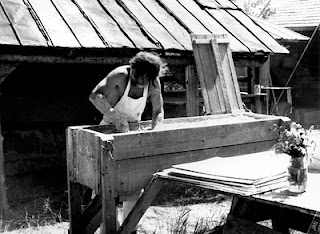PETER SCHUMANN RYE BREAD
Although potentially heavy as lead and tough as 16-penny nails, this bread is addictively delicious to eat, though not particularly easy to make. Schumann rye should be eaten after it has thoroughly cooled. Slice it thinly, and consider wearing gloves to protect your hands if you have a lot of slicing to do. Store your loaf at room temperature in a paper bag, and it will keep for days. Those who acquire a taste for sour rye often consider it their favorite bread, although it will, without doubt, precipitate tired jaw syndrome (TJS).
YIELD: 2 small round loaves
DAY 1
Ingredients:
2 cups warm water 105-115° F
2 cups rye flour
Peter Schumann at the sourdough trough
In a medium-sized mixing bowl, thoroughly stir the rye flour into the warm water. Cover the bowl with a plate, and leave in a warm place (70-80ºF). The souring process should be under way. Give it a stir everyday.
Approximately 3 days later you need:
2 teaspoons salt
1 1/4 cups rye flour
After about 3 days the rye mixture should have a sour aroma, and it should be bubbling. It might take only 2 days or it could take as long as 5 days. Room temperature determines the length of time necessary. The warmer the environment, the more quickly the rye will sour. If mold forms on the top, as it has on mine, Peter says not to worry about. I did worry about it, but scraped the mold off as he said to, and I’m still healthy.
When the rye has reached the level of sourness that seems right to you (trust your instincts here), stir in the salt and about 1 1/4 cups of rye flour. The amount of flour can vary considerably with this recipe, but this shouldn’t daunt you because you are by now well aware of the many variables in bread baking. The rye mixture should be quite dense. Cover and let ferment overnight.
The next day, turn out the dough on a heavily floured surface. Expect the dough to remain sticky. It’s rye we’re working with. Divide the dough in two, fold and place on your floured peel. The dough should not be taller than 1” or it might burn before it bakes through. You’ve fired your oven, removed the ashes and cleaned the floor. Bake in a medium oven until done. Slice thinly and dip in extra virgin olive oil in which you’ve crushed some fresh garlic.If any of you bread bakers or oven builders have images or words to share, email them to me, and I might put them up on the blog.
Stu






